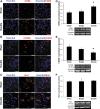Partial Depletion of Microglia Attenuates Long-Term Potentiation Deficits following Repeated Blast Traumatic Brain Injury in Organotypic Hippocampal Slice Cultures
- PMID: 36508265
- PMCID: PMC10081725
- DOI: 10.1089/neu.2022.0284
Partial Depletion of Microglia Attenuates Long-Term Potentiation Deficits following Repeated Blast Traumatic Brain Injury in Organotypic Hippocampal Slice Cultures
Abstract
Blast-induced traumatic brain injury (bTBI) has been a health concern in both military and civilian populations due to recent military and geopolitical conflicts. Military service members are frequently exposed to repeated bTBI throughout their training and deployment. Our group has previously reported compounding functional deficits as a result of increased number of blast exposures. In this study, we further characterized the decrease in long-term potentiation (LTP) by varying the blast injury severity and the inter-blast interval between two blast exposures. LTP deficits were attenuated with increasing inter-blast intervals. We also investigated changes in microglial activation; expression of CD68 was increased and expression of CD206 was decreased after multiple blast exposures. Expression of macrophage inflammatory protein (MIP)-1α, interleukin (IL)-1β, monocyte chemoattractant protein (MCP)-1, interferon gamma-inducible protein (IP)-10, and regulated on activation, normal T cell expressed and secreted (RANTES) increased, while expression of IL-10 decreased in the acute period after both single and repeated bTBI. By partially depleting microglia prior to injury, LTP deficits after injury were significantly reduced. Treatment with the novel drug, MW-189, prevented LTP deficits when administered immediately following a repeated bTBI and even when administered only for an acute period (24 h) between two blast injuries. These findings could inform the development of therapeutic strategies to treat the neurological deficits of repeated bTBI suggesting that microglia play a major role in functional neuronal deficits and may be a viable therapeutic target to lessen the neurophysiological deficits after bTBI.
Keywords: electrophysiology; hippocampus; long-term potentiation; microglial depletion; repeated blast traumatic brain injury.
Conflict of interest statement
No competing financial interests exist.
Figures







References
-
- Defense and Veterans Brain Injury Center. Department of Defense Worldwide Numbers for Traumatic Brain Injury. Armed Forces Health Surveillance Center, Defense and Veterans Brain Injury Center: Silver Spring, MD; 2018.
Publication types
MeSH terms
Grants and funding
LinkOut - more resources
Full Text Sources
Medical
Research Materials
Miscellaneous

